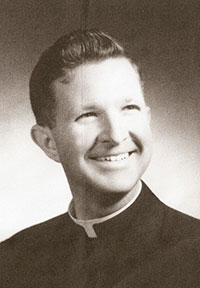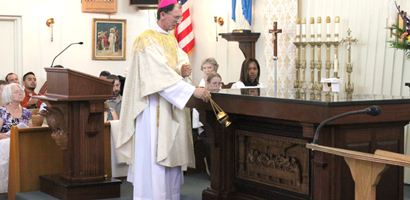 REIDSVILLE — Joyful music in English, Spanish and Latin marked the 50th anniversary celebration at Holy Infant Church in Reidsville June 24.
REIDSVILLE — Joyful music in English, Spanish and Latin marked the 50th anniversary celebration at Holy Infant Church in Reidsville June 24.
Holy Infant Church was dedicated on June 26, 1962, and 50 years later, the church's pews were filled with worshippers strong in their faith and in their Catholic witness in Rockingham County.
With Father Joseph Mack, pastor, as concelebrant, Bishop Peter Jugis celebrated the anniversary Mass and blessed the church's new altar. The new altar and ambo, built by a parishioner of Holy Infant Church, were among recent renovations to this unique architectural gem that also included installation of faceted glass windows.
Pictured above: Bishop Peter Jugis incenses the new altar at Holy Infant Church in Reidsville during a Mass June 24 to celebrate the 50th anniversary of the church's dedication. View a full gallery from the event at the bottom of the article. (Photos by Patricia L. Guilfoyle, Catholic News Herald)
THE CHURCH
On this anniversary of the church's dedication, Bishop Jugis said during his homily, it was an occasion to think about the three purposes of a church building.
A church is primarily a place set aside for the celebration of the sacraments and the Church's highest prayer, the sacrifice of the Mass, he said.
A church building also provides a means of transformation: by participating in the Mass and receiving the grace from the sacraments, Catholics conform more closely to Christ, becoming living temples of the Spirit. And in the case of Holy Infant Church, its recent renovations are symbolic of the parish's continual spiritual growth, Bishop Jugis noted.
"Just as the interior of this church has changed so beautifully as it has been renovated, you must also be changed – you must also become more beautiful," he said. "The external transformation of the interior of the church should be a reflection of what is constantly taking place within your own heart, within your own soul – being transformed by God's grace, becoming more loving, more holy, more grace-filled."
Bishop Jugis then recounted a story about the time an interviewer slyly asked Blessed Teresa of Calcutta what must be changed in the Church. Blessed Teresa gave a very interesting answer, he said: "The first thing that needs to change in the Church is you and I."
Thirdly, Bishop Jugis explained, churches are a tangible presence of the universal Catholic Church in a community, especially important in areas like Reidsville where Catholics are a minority. The church and its parish community can be a tool of evangelization and understanding of the faith.
And through our involvement in our parishes, we can link our faith to our actions, he said, enabling us to share the Gospel message with the wider community.
On the occasion of the church's anniversary, Bishop Jugis said, it is an opportune time to ask: "Are we bringing the light of Christ into our community, to scatter the darkness of this culture – sometimes called the culture of death, but also the culture of selfishness, a culture of materialism, a culture of relativism?"
In his remarks at the conclusion of Mass, Father Mack thanked all the parishioners who helped organize the anniversary celebration.
"The parish church stands as a good testament to the witness of the hard work of a small parish and its ability to endure the many challenges that have faced it over its history," Father Mack said. "It is an honor to be able to serve them as pastor."
Following Mass, parishioners gathered together under tents for a picnic and fellowship.
HISTORY
When Holy Infant Church was built in 1962, there were just a handful of Catholics in the area, then a booming community powered by tobacco and textiles.
Early on, local Catholics went to Greensboro or Danville, Va., for Mass, then for years later they traveled to Eden, where St. Joseph of the Hills Church was built in 1938.
In 1951, Catholics obtained permission to have Mass said at a local funeral home in Reidsville and then at Reidsville Municipal Building. As the number of faithful grew, the second floor of a local washerette was converted into a chapel and classroom space.
Through the influence of Mrs. Ashby Penn, a local philanthropist, the families were able to acquire land to build a church. At the bishop's request, they chose a hilltop site along the highway going into Reidsville – a visible location that would be easily accessible to Catholic travelers.
First they built a temporary chapel, later used as the rectory, and then with financial help from a Connecticut family interested in building churches in mission areas, they were able to finally construct a permanent church.
The church was dedicated on June 26, 1962, by Bishop Vincent Waters. The Connecticut family named the church Holy Infant.
A lot of the church furnishings were given as memorials from local families and companies, including American Tobacco Co., the area's leading employer.
But even with the growth and the new church, Holy Infant remained a mission church. Then in 1967, the church community became a parish on its own and received its first full-time pastor, Father Edward O'Doherty.
In 1982, the church underwent significant repairs after an unknown arsonist set fire to the building and caused considerable damage.
In 1985, the church was appointed the diocese's first permanent parochial administrator, Sister Pauline Mary Clifford, by Bishop John F. Donoghue.
Also in 1985, Father Peter Jugis, then pastor, began celebrating Mass in Spanish regularly each Sunday, drawing Hispanic Catholics from across Rockingham County as well as in nearby Virginia and as far south as Greensboro to be able to worship in their native language. He also served as pastor of Holy Infant Church from 1993 to 1996, so this 50th anniversary Mass was a kind of homecoming for him as well.
Now, about 150 Catholic families call Holy Infant Church their home, comprised of a diverse cultural mix of English- and Spanish-speaking Catholics.
ARCHITECTURE
Holy Infant Church is probably the most unusual looking church in the diocese.
Its architect was Richard Burke Schnedl of Reidsville, a North Carolina native who was in the first graduating class at N.C. State University's School (now College) of Design.
Schnedl was a devotee of Frank Lloyd Wright, and his designs featured similarly simple lines, open floor plans and understated elegance.
His design for the church featured bold white stucco walls, accented by piercing angular windows and high skylights, an outward-angled front door, and a curved roof line. Inside, the white walls and geometric accents highlight the crucifix mounted behind the altar. The accompanying bell tower is built of similar white stucco.
RECENT RENOVATIONS
Since its dedication 50 years ago, the church has undergone a few minor modifications, but nothing as significant as what the parish did in anticipation of the 50th anniversary of the church's dedication.
Parishioners and Father Mack raised funds to purchase the new faceted glass windows, made in a modern design to complement the church's contemporary architectural style.
(To see the unique faceted glass window designs, click here: http://s15.photobucket.com/albums/a378/frjoemack/New%20Church%20Windows)
Parishioner John Savinski constructed a new altar and ambo of dark wood, which contrasts with the church's white interior to set off the sanctuary and make it even more of the focal point for the church. Savinski also constructed a new altar of repose for the tabernacle, a new ambry (cabinet that keeps the three sacred oils used in the sacraments), and wall pedestals for the statues of the Blessed Virgin Mary and St. Joseph.
PRIESTS AND RELIGIOUS WHO SERVED AT HOLY INFANT PARISH
1962-1966 Father Thomas Clements
1966-1967 Monsignor Dennis Lynch
1967-1978 Father Edward O'Doherty
1978-1979 Father Gabriel Meehan
1979-1982 Father Joseph McCarthy
1982-1985 Father Don Baker
1985 Father Peter Jugis
1985-1988 Sister Pauline Mary Clifford, parochial administrator
1986 Father Carl Kaltreider
1986-1988 Father Tom Stott
1988-1989 Father Ron Marecki
1989-1990 Father Raymond B. Hourihan
1990 Father Cecil Tice
1990-1993 Father Richard Sotelo, S.J.
1993-1996 Father Peter Jugis
1996-1997 Father Joseph Valentine
1997-2000 Father John T. Putnam
2000-2005 Father Christopher Davis
2005 Father Luis Osorio
2006 Father Christopher Roux
2006-present Father Joseph W. Mack
Learn more about Holy Infant Church of Reidsville: www.holyinfantreidsvillenc.com.
— Patricia L. Guilfoyle, editor
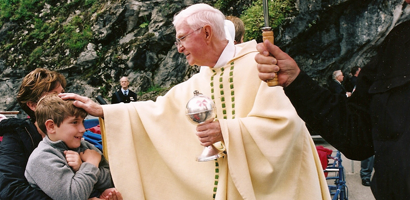 On Friday, May 25, Bishop Emeritus William G. Curlin celebrated 55 years as a priest by administering the sacrament of confirmation to 75 children at St. Thérèse Church in Mooresville.
On Friday, May 25, Bishop Emeritus William G. Curlin celebrated 55 years as a priest by administering the sacrament of confirmation to 75 children at St. Thérèse Church in Mooresville.
"I continue to help Bishop (Peter) Jugis with confirmations throughout the diocese," Bishop Curlin says. "I am encouraged and deeply moved when people invite me to special occasions and celebrations."
As a retired priest, Bishop Curlin sees his current ministry as one of providing this spiritual support to God's people.
Pictured: Bishop William Curlin is pictured blessing a child at the Shrine of Our Lady of Lourdes, France. (Photos provided by Diocese of Charlotte and Catholic News Herald archives)
Primarily, this ministry brings him to hospitals and nursing homes, which he visits on a daily basis.
"I find in my own retirement being very busy," he explains. "I no longer have all of the administrative duties and responsibilities – thanks be to God! But I feel myself free now to totally devote myself to the spiritual needs of God's people... I see this ministry to the sick and dying as a gift from God."
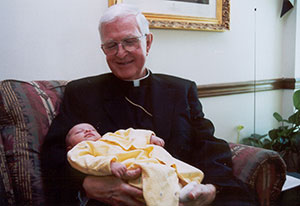 Even the nurses know that he is available at a moment's notice to come to the aid of a sick or dying person.
Even the nurses know that he is available at a moment's notice to come to the aid of a sick or dying person.
"I shave before I go to bed, and I shave as soon as I get up," Bishop Curlin explains laughing. He wants to be ready any time day or night that a sick or dying person is in need of the sacraments.
Forming a habit of serving
From his first parish assignment after ordination as assistant to the senior auxiliary bishop of Washington, D.C., John MacNamara, Bishop Curlin has devoted his priestly life to spiritual and corporal works of mercy.
"I was told by my first pastor: your primary task as a priest is to help people form an intimacy with Jesus Christ in their personal life," he says. "He kept repeating Jesus' words that He would live in us. And that's the same message as Mother Teresa. My first pastor and Mother Teresa had the same words: a Christian's life is to reveal the Christ in them in the way they treat others."
It's no wonder, then, that Mother Teresa and Bishop Curlin formed a fast friendship when they first met in the early 1970s. "People could criticize me maybe for mentioning her too many times!" Bishop Curlin says, laughing.
But his work with the famed nun – whom Bishop Curlin calls "one of the greatest saints of our times" – led him to aid in founding homes for the poor and homeless with terminal diseases, notably AIDS.
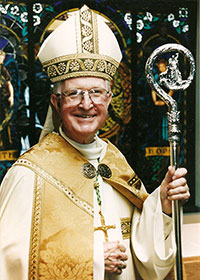 "Gift of Peace" is the home in Washington, D.C., for those dying of AIDS and other terminal conditions. It is staffed by Mother Teresa's sisters.
"Gift of Peace" is the home in Washington, D.C., for those dying of AIDS and other terminal conditions. It is staffed by Mother Teresa's sisters.
"It's very sad sometimes – the loved ones don't want them, they don't seem to care about them," Bishop Curlin recalls. "We had one little girl there. She was not a Catholic; she was 7 years old, but we said she was an angel in many ways and a joy to know. And I had the privilege of presiding at her funeral at the cemetery."
"These people are dying wanting to be loved," he says. "And nobody ever died at Gift of Peace without knowing they were loved and we were keeping them in our prayers. It's hard to die unloved and unwanted. And Mother opened the home for that reason, so people would know they weren't abandoned, that they were loved by God."
'Adsum'
"The day I was ordained, we used the word 'adsum' when we stepped forward to present ourselves for ordination," the retired bishop explains of the Latin phrase for 'I am present' that is used in the ordination Mass.
This little answer, however, became a daily part of his spiritual life.
"Every day I repeat that word. I need to say it not just once when I became a priest, but every day. You re-consecrate your life to Jesus through prayer, through devotion to the Blessed Sacrament, and a willingness to spend your life in serving others."
Even as a bishop, he never saw his vocation as a job, but as a privilege and a joy.
"If the bishop loves his priests, they will in turn be good pastors," he explains. "For example, I can think of several occasions where priests were not well, and I took them into my home and took care of them until they got back on their feet again. It was such a privilege to do that, to help them return to good health."
Inspired by others
Bishop Curlin explains that a priest's devoted life will inspire young people to consider vocations today. He himself found his priestly vocation in looking up to the priests and nuns from his life in post-World War II Washington, D.C.
"Following World War II, people were discouraged by all the horrors of the war, looking for peace and joy, and I observe now over the years that I look back to how these priests and sisters inspired me to think seriously about the priesthood.
"We were blessed with wonderful priests. They were so joyful! They were so dedicated! And we had wonderful sisters in our schools – they were an inspiration.
"There has never been a moment that I haven't thanked God for this great privilege, and I pray that God will inspire many young men to come forward (to become priests) and many young men and women to offer themselves in religious life."
To young men considering the priesthood, he urges them to speak to a priest to discern, but also to understand the demands that being a priest has on a man. The man should consider whether he has the qualities and virtues to meet those demands.
And most importantly, the young man, Bishop Curlin says, must have the heart of Christ.
"I have been privileged to ordain over 100 men to the priesthood in 24 years as a bishop. I know when I laid my hands on them, they're a priest. However, each man must bring with him the heart for it, the disposition for it, the kindness for it, the mercy and the love that the priesthood demands. Each man must bring that himself."
— Mary B. Worthington, correspondent
EDITOR'S NOTE: The Diocese of Charlotte was founded on Jan. 12, 1972. To celebrate the 40th anniversary of the diocese and the history of the Church in western North Carolina, we are publishing a year-long series spotlighting the people who built up the Church, the major developments over the past 40 years, and what changes could be in store for the future.
Bishop Emeritus William G. Curlin
Episcopal motto: "Sentire Cum Christo" ("To Think With Christ")
May 25, 1957 – Ordained by Cardinal Patrick O'Boyle, St. Matthew Cathedral, Washington, D.C.
1957 – Assistant to Bishop John McNamara, St. Gabriel Parish, Washington, D.C.
1964 – Assistant Pastor, Our Lady of Sorrows Parish, Takoma Park, Md.
1967 – Assistant Director of Vocations for Men and Assistant Pastor in St. Ann Parish, Washington, D.C.
1968 – Director of Vocations for Men and Director of Formation Program, Catholic University of America, for Washington Candidates for the Priesthood
1969 – Appointed Chaplain to Pope Paul VI
1970 – Pastor of Old St. Mary's Church, Washington, D.C.
Director of Vocations for Men
Director of Permanent Diaconate Program, Archdiocese of Washington, D.C.
1978 – Appointed Prelate of Honor by Pope John Paul II
1983 – Pastor, Nativity Parish, Washington, D.C.
1988 – Ordained as Auxiliary Bishop of Washington, D.C.
1994 – Installed as Bishop of Charlotte
2002 – Resigned as Bishop of Charlotte
More online
History of the Diocese of Charlotte: www.charlottediocese.org/history
Anecdota in the Diocese of Charlotte's history: www.charlottediocese.org/ministries-a-departments/archives
See the full special edition from Bishop Curlin's retirement


